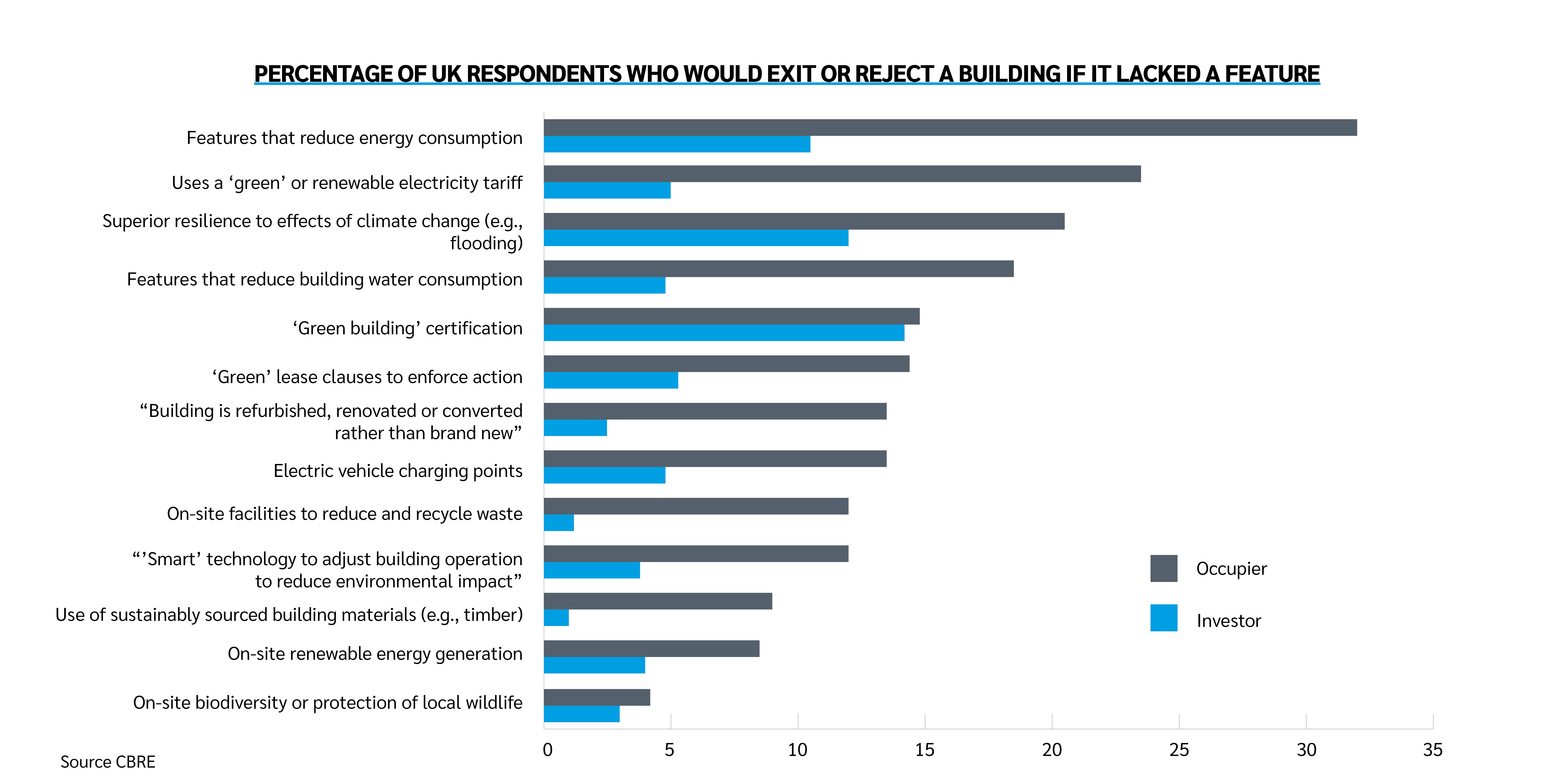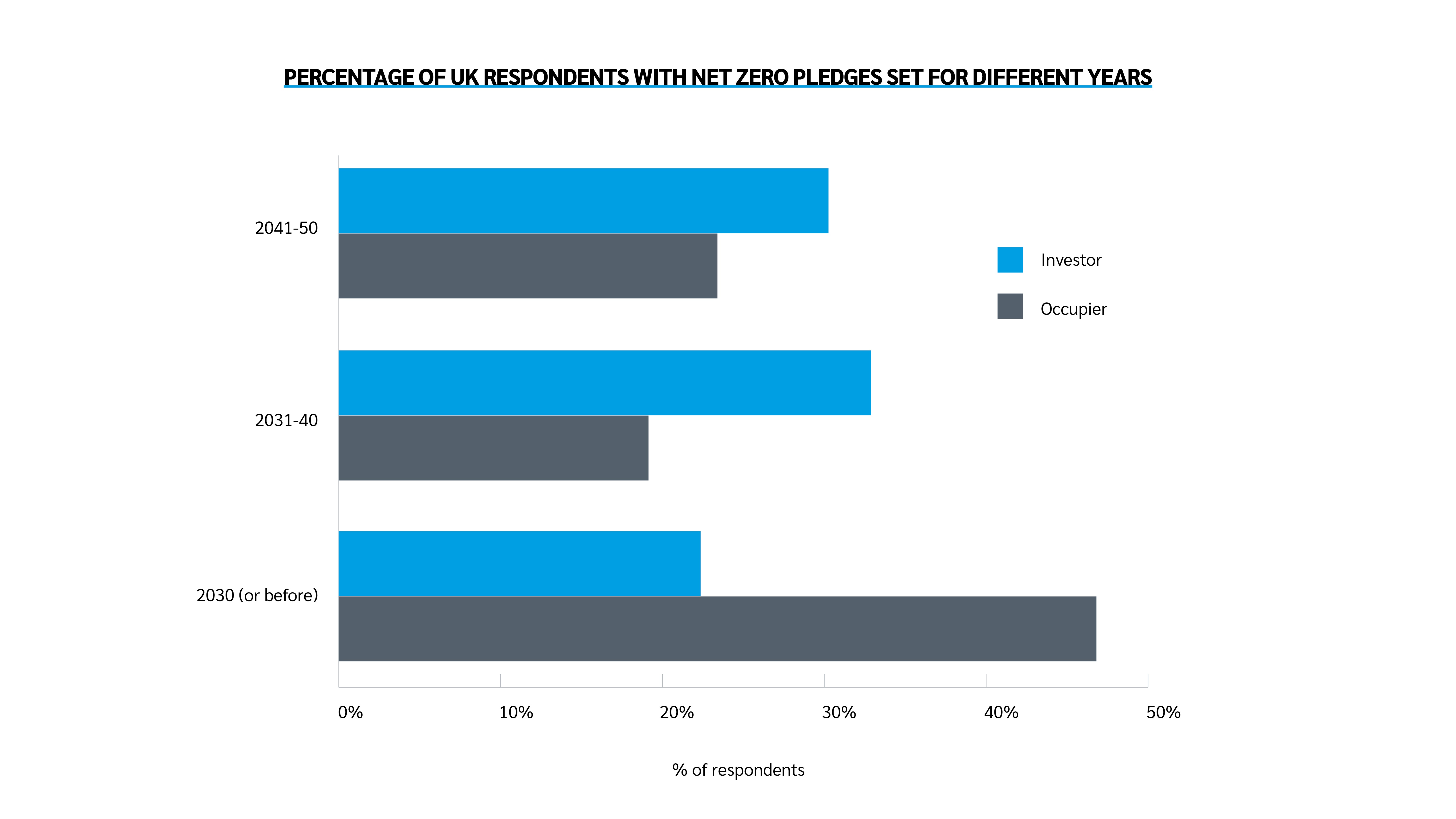Environmental, social and governance (ESG) factors are playing an increasing role in the real estate sector. This is creating a new dynamic in the market as both occupiers and tenants adjust their priorities and pricing expectations.
Occupiers driving demand for ESG buildings
ESG strategies will impact real estate values in the future. This is because tenants will prefer buildings with strong ESG credentials. As a result, there will be an increase in demand and prices for prime properties.
A recent survey (opens a new window) conducted by commercial real estate services and investment firm CBRE with over 500 real estate professionals shows that occupiers are much more likely than investors to reject a building if it lacks ESG features. While the price occupiers will be prepared to pay for each of the features is an unknown variable, the results may give investors an indication of the features they want to prioritise when upgrading buildings or investing in new ones.

The differing importance given to ESG features by investors and occupiers suggests that demand for buildings with strong ESG credentials is going to outstrip supply in the near future, a fact that is set to further impact property values.
Another driver for a reorganisation of the market around ESG factors is the misalignment of occupiers’ and investors’ net zero pledge timings. On average, occupiers have a much earlier net zero pledge timing than investors. This is again set to boost demand for buildings with strong ESG credentials.

Of course, precisely how far real estate values are going to diverge due to ESG factors will depend on the price that occupiers are prepared to pay for a building that reflects their expectations.
Investors face multiple challenges
During a recent roundtable organised by Lockton to explore the implications ESG factors have on the real estate sector, investors mentioned that the current economic climate with high interest rates and sluggish growth is not supportive of investments in real estate. For some, making the necessary ESG related investments in the infrastructure across the portfolio may be unviable.
At the same time, banks as well as accountants are pushing for property developers to incorporate measures to align with the UK government’s net-zero strategy. Investing in ESG can be profitable for those who have the means. This is because there will be a higher demand for prime real estate compared to the available supply. In any case, there was consensus amongst roundtable participants that new stock will aim for high ESG certification.
While some investors have screenings for occupiers that don’t match their ESG focus such as tobacco or fossil fuels, there doesn’t seem to be hard evidence for a direct link between a non-ESG aligned occupier and the value of the property, according to the survey. As a result, many investors are keeping their focus on profitability only.
One challenge shared by both investors and occupiers is the difficulty of collecting the necessary data to calculate a given building’s CO2 footprint. This is important to track progress towards net zero goals and to validate initial ESG investments.
In the global version of the CBRE survey (opens a new window), 66% of investors and 48% of occupiers reported that poor availability or quality of data poses a challenge – making it the biggest barrier to delivering on ESG goals. Data collection limitations include a lack of alignment between standards and reporting requirements, and limited data sharing between occupiers and investors.
The importance of engaging insurers early
Adding features like vertical gardens or rooftop solar panels to buildings for ESG purposes can bring new risks for insurance. For instance, green roofs can dry out, creating a potential fire risk. Similarly, solar panels can cause an electrical short, which may result in a fire.
Insurers’ resilience teams are trained to analyse these potential risks. As such, it is paramount to involve them early in the development process. Sharing information and discussing may lead to finding new solutions that lower costs and bring more benefits for an investor.
In one case mentioned during the Lockton roundtable, an occupier argued against the installation of sprinklers as a means to mitigate the risk of fire in a warehouse, owing to the potential for the released water to damage goods and create additional losses. Instead, both parties agreed that reducing the oxygen levels in the warehouse would be a much more suitable option.
For further information, please visit our Global Real Estate and Construction page (opens a new window), or contact: Rachel Norris - Global Real Estate Practice
It is clear from our survey responses that ESG features have an impact beyond the ‘green premium.’ Significant numbers of investors and occupiers now consider certain ESG features as standard and are not willing to pay market price when they are absent from a building. Investing in ESG features is no longer only about achieving a premium, it is essential to retaining asset value.
Testimonial from Toby Radcliffe, CBRE


